news
![]()
October 12, 2016
Two schools of thought are better than one for water sustainability solutions

 Public policy and landscape ecology are two schools of thought that don’t normally intermingle in academic research. But a recent study from the UW-Madison Water Sustainability and Climate project brought them together to explore how well policy-based efforts to improve water quality are targeting areas of greatest concern.
Public policy and landscape ecology are two schools of thought that don’t normally intermingle in academic research. But a recent study from the UW-Madison Water Sustainability and Climate project brought them together to explore how well policy-based efforts to improve water quality are targeting areas of greatest concern.
Proof of the value of crossing disciplines to seek solutions for sustaining water resources, the study’s findings reveal where increased policy attention could be placed geographically to gain more ground in cleaning up our lakes and rivers.
According to lead author Jiangxiao Qiu, a recently minted PhD graduate, the study’s interdisciplinary approach was key to garnering such insights.
“Space is an important dimension in managing freshwater resources,” says Qiu, who is now a postdoctoral fellow with The Nature Conservancy. “Figuring out where policy attention is needed and leveraging policies to manage multiple freshwater targets could help achieve greater benefits from policy implementation.”
Qiu is a landscape ecologist, which means he studies the patchwork of ecosystems that make up large swaths of land and how those assorted patches function to provide people ecosystem services, or natural benefits such as food production, water quality and flood regulation.
His primary co-author is Chloe Wardropper, a social scientist who studies how people employ policies to manage and improve freshwater resources, and how well that implementation is working.
The landscape they examined is Wisconsin’s Yahara Watershed, a region mottled with farmland and urban development, where there has been great investment in improving water quality in its five lakes but no measurable improvement.
Their results point to a “misfit” between where efforts to reduce nutrient pollution are implemented on the ground and where the biggest sources of that pollution lie on the landscape. Addressing this disconnect is crucial to cleaning up the lakes.
“Our approach was meant to help get a more nuanced picture of how and where we focus public effort, and what policy can do to improve ecosystem services,” says Wardropper, a PhD candidate in environmental studies.
A major need their findings highlight is for more policy implementation in intensively farmed areas, places where small changes could bring big gains to water quality.
Moreover, targeted efforts could enhance not just water quality, but also other water-related benefits provided by the landscape, such as flood regulation and groundwater supply. Best management practices on farms or detention ponds in urban areas are examples of efforts with multiple positive effects.
“Even if a project is intended to clean up our lakes, we need to think about how it could be leveraged to improve the other water-related services,” says Wardropper.
Qiu says their findings demonstrate the importance of taking a holistic view, in addition to multiple disciplinary perspectives, when managing landscapes to reap the benefits people want from them.
“Different policies have their own goals, functions and limits. It is important to account for the full portfolio of possible actions and how they can complement each other to enhance freshwater benefits across diverse landscapes,” he explains.
The study was published in the journal Landscape Ecology.


